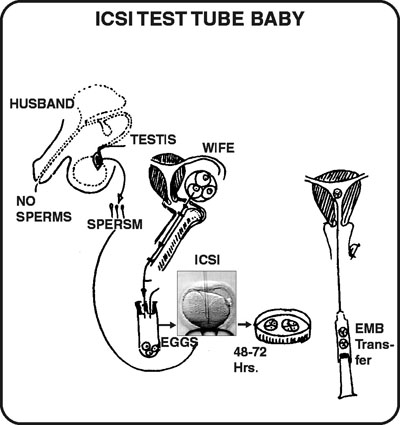ICSI: Advanced Treatment for Male Infertility and Fertility Challenges
Intracytoplasmic Sperm Injection (ICSI) is a specialized fertility treatment designed to help couples where male infertility is a key challenge. ICSI is typically recommended when the male partner has issues such as very low sperm count (azoospermia or oligozoospermia), poor sperm motility (asthenozoospermia), abnormal sperm shape (teratozoospermia), or a combination of these conditions, known as Oligoasthenoteratozoospermia (OATS). In the ICSI procedure, a single sperm is carefully injected into an egg to facilitate fertilization. For men with no sperm in their ejaculate, sperm can be retrieved directly from the testes using procedures like Testicular Sperm Extraction (TESE) or Testicular Sperm Aspiration (TESA).
This process uses advanced micromanipulation technology to ensure successful fertilization. ICSI is often the go-to method for couples who have not succeeded with conventional IVF, offering a new avenue for achieving pregnancy.
About Intracytoplasmic Sperm Injection (ICSI)
Intracytoplasmic Sperm Injection (इंट्रासाइटोप्लाज़मिक स्पर्म इंजेक्शन) is a highly specialized procedure within assisted reproductive technology (ART) that involves injecting a single sperm directly into the cytoplasm of an egg to achieve fertilization. This technique is performed using advanced micromanipulation tools and requires the expertise of skilled embryologists. ICSI is particularly beneficial in cases of male infertility, where conventional IVF may not yield successful fertilization.
Once the sperm is injected into the egg, the fertilized egg is monitored to ensure successful cell division and development. The embryo is then either transferred fresh into the uterus or frozen for future use. Frozen Embryo Transfers (FET) have become a popular choice, offering more control over timing and increasing the chances of a successful pregnancy. By freezing high-quality embryos, couples can also preserve them for later use or future sibling pregnancies.
ICSI Process: Step-by-Step Overview
The ICSI process involves several critical steps to ensure successful fertilization. After ovarian stimulation, eggs are retrieved from the female partner’s ovaries in a minimally invasive procedure. Simultaneously, sperm is collected from the male partner, either through ejaculation or surgical retrieval techniques like TESE or TESA if necessary. Once the eggs and sperm are obtained, the embryologist carefully selects the healthiest sperm to inject into the eggs.
Using a fine needle and advanced micromanipulation technology, a single sperm is injected directly into the cytoplasm of each mature egg. The fertilized eggs are then monitored for cell division and development over the next few days. Once the embryos reach the optimal stage, usually the blastocyst stage, they are either transferred to the uterus or frozen for future use. This meticulous process requires precision and expertise to achieve successful fertilization and maximize the chances of pregnancy.
ICSI (आईसीएसआई) at Ideal Fertility Clinic?
At Ideal Fertility Clinic, we leverage the latest technologies and techniques to optimize the chances of success with ICSI. Similar to conventional IVF, the ICSI procedure begins with ovarian stimulation to encourage the production of multiple eggs. The eggs are surgically retrieved and prepared for the fertilization process. The surrounding cumulus corona cells are removed to allow the embryologist to assess the maturity of each egg.
If the male partner’s sperm is not present in the ejaculate, we perform either TESE or TESA to collect sperm. This ensures that even in cases of severe male infertility, sperm can still be retrieved for the fertilization process.
The retrieved eggs are placed under a microscope equipped with a high-quality micromanipulator, like the Nikon Narishige system we use at Ideal Fertility. This advanced system allows us to magnify the egg up to 400 times, ensuring precision during the fertilization process. A holding pipette, approximately 40 to 50 micrometers in diameter, holds the egg in place while a fine intracytoplasmic injection needle (5-6 micrometers wide) is used to inject the sperm directly into the egg.
The sperm used for ICSI (आईसीएसआई) is carefully selected, immobilized with PVP (polyvinylpyrrolidone) or by gently tapping its tail, and then loaded into the injection pipette. This highly controlled process takes only a few minutes but requires the expertise of our skilled embryologists to achieve optimal results. Fertilization is assessed 16-18 hours post-injection to confirm success.
Success Rates and Blastocyst Transfer
At Ideal Fertility Clinic, ICSI fertilization typically results in a success rate of around 65%. While this is a high success rate, it is important to note that not all injected eggs will result in fertilization. Once fertilization is confirmed, the embryos are cultured in a controlled, low-oxygen environment for 5-6 days until they reach the blastocyst stage. These blastocysts are then carefully transferred into the uterus, where they have a high chance of implanting and resulting in a successful pregnancy.
Achieving Success with इंट्रासाइटोप्लाज़मिक स्पर्म इंजेक्शन at Ideal Fertility Clinic
ICSI is an excellent option for couples struggling with male infertility or those who have experienced previous IVF failures. At Ideal Fertility Clinic, we combine cutting-edge technology, such as our high-precision micromanipulation systems, with the experience of our expert embryologists to ensure the best possible outcomes for our patients. With our personalized approach, we help turn your dream of parenthood into a reality.

